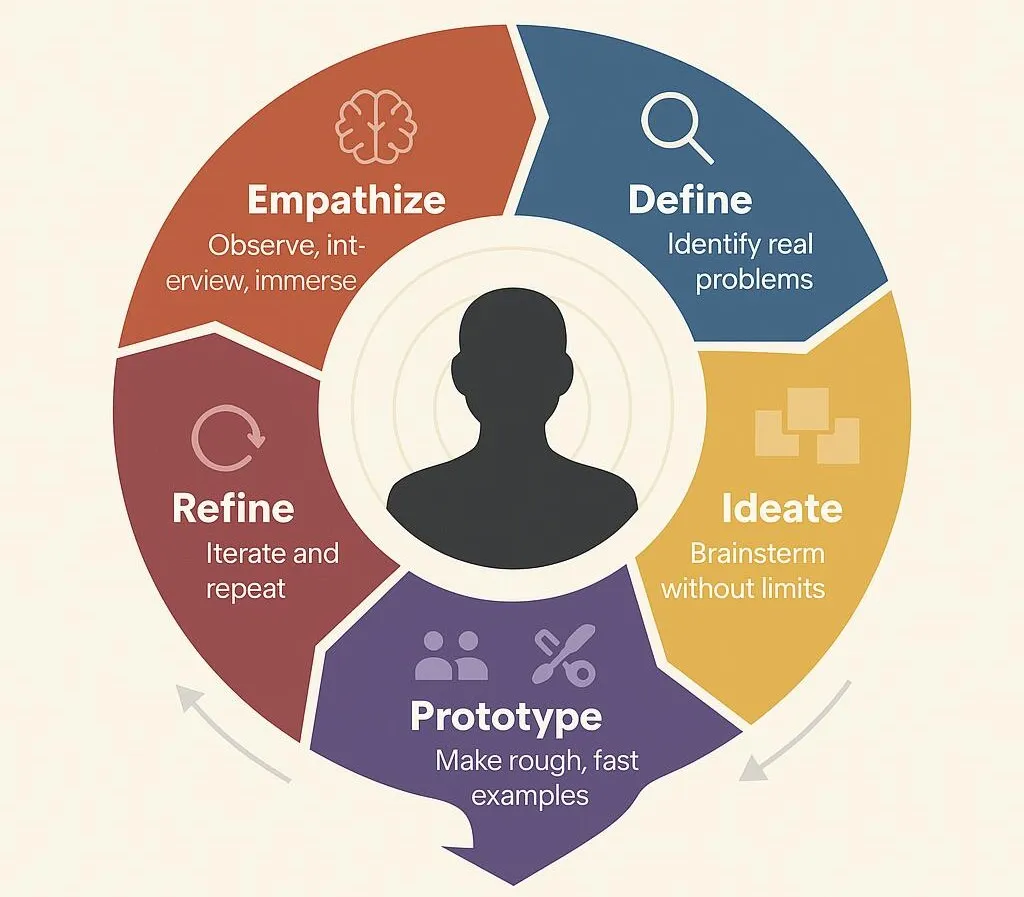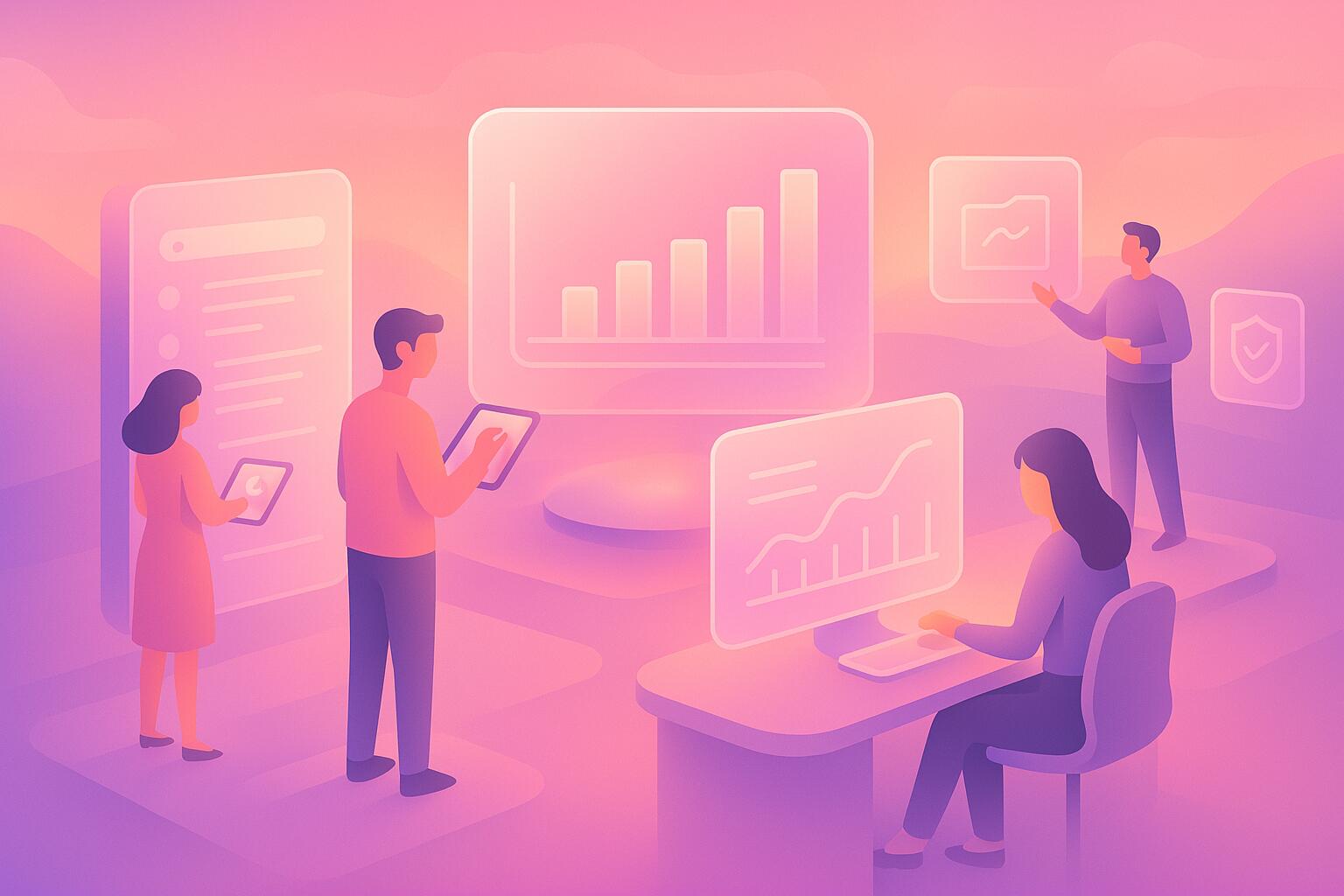· Design · 7 min read
The Design Approach That Puts People Before Pixels
Discover how human-centered design creates intuitive experiences by focusing on needs, behaviors, and emotions rather than just visual aesthetics or technical capabilities.

The Magic Behind Intuitive Experiences
Have you ever used an app or website that just seemed to understand exactly what you needed? Everything feels natural—buttons placed right where your thumb naturally rests, language that speaks to you directly, and workflows that match how you actually think. This seamless experience isn’t accidental—it’s the result of human-centered design, an approach that prioritizes people over technology.
In a digital landscape cluttered with products competing for attention, the difference between good and exceptional often comes down to a simple question: was this designed for the technology, or for the humans using it?

Beyond Features: Understanding Human-Centered Design
Human-centered design isn’t merely a methodology—it’s a philosophy that places people at the core of every decision. Unlike traditional approaches that might begin with technical specifications or business requirements, human-centered design starts with understanding the people who will ultimately use your product.
At its essence, it follows a cyclical process:
- Empathize with users through deep observation and conversation
- Define the underlying problems that need solving
- Ideate creative solutions without constraints
- Prototype concepts quickly to make ideas tangible
- Test with real users and gather authentic feedback
- Refine based on insights and repeat
This approach transforms the design process from an exercise in aesthetic preference to a rigorous exploration of human needs, behaviors, and motivations.
The Profound Impact of Putting People First
Solving Real Problems, Not Assumed Ones
Too often, products are built based on presumptions about what users need. A team brainstorms internally, drawing from their own experiences and biases. The result? Features that address problems users don’t actually have while overlooking the challenges they face daily.
Human-centered design reverses this dynamic. Through methodical research—interviews, contextual inquiry, usability testing—designers uncover the genuine pain points in users’ lives. This foundational understanding ensures products solve meaningful problems rather than creating elegant solutions to non-existent issues.
Consider how different the mapping experience is today compared to paper maps. Digital maps didn’t simply digitize paper—they fundamentally reimagined navigation by understanding what people actually struggle with: knowing which direction to turn, finding points of interest, and receiving real-time traffic updates.
Creating Emotional Connections
Products that truly resonate don’t just perform functions—they create emotional connections. When users feel understood, they develop loyalty that transcends feature comparisons or price considerations.
This emotional dimension often emerges from attention to seemingly minor details: the encouraging message after completing a difficult task, the thoughtful defaults that save time, or the microcopy that speaks in a human voice rather than technical jargon.
These touchpoints demonstrate empathy, showing users that real humans designed this product with care and understanding. The result is not just satisfaction but genuine affection for the experience.
Reducing Development Waste
Building the wrong thing is exponentially more expensive than taking time to discover the right thing. Companies often rush into development only to realize later—sometimes after launch—that their product misses the mark entirely.
Human-centered design introduces validation checkpoints throughout the process. Early prototypes, even rough sketches, can reveal misalignments between the proposed solution and user needs. By catching these disconnects early, teams avoid the costly cycle of build-launch-fail-rebuild that plagues many product development efforts.
The Practice of Human-Centered Design
Step 1: Immerse Yourself in Users’ Reality
Genuine understanding cannot happen at a distance. It requires immersion in the contexts where your product will be used. This means going beyond survey data to observe users in their natural environments.
Effective techniques include:
- Shadowing users as they complete tasks related to your product
- Contextual interviews where questions arise from observed behaviors
- Diary studies capturing experiences over time
- Empathy exercises where team members simulate user limitations
The goal is to uncover not just what users say they do, but what they actually do—including workarounds, pain points, and unmet needs they may not even recognize themselves.
Step 2: Reframe Problems Through the Human Lens
With rich observational data in hand, the next challenge is synthesis. What patterns emerge? What underlying needs connect seemingly disparate behaviors?
This synthesis often reveals that the real problem differs significantly from the initially perceived one. For example, a team might begin believing users need more filtering options in a search interface, only to discover the core issue is information overload. The solution might not be more filters but a fundamentally different approach to organizing content.
This reframing requires setting aside preconceptions and being willing to pivot based on genuine insights rather than predetermined solutions.
Step 3: Co-Create with Users
Human-centered design recognizes that the best solutions often emerge from collaboration between designers and users. Rather than treating users merely as subjects for testing completed designs, this approach invites them into the creative process.
Co-creation sessions bring users and designers together to generate ideas, build rough prototypes, and evaluate concepts in real-time. This collaborative approach yields solutions that might never have emerged from the design team alone while building user investment in the final product.
Step 4: Iterate Based on Real Behavior
Perhaps the most distinctive aspect of human-centered design is its commitment to iteration based on observed behavior rather than opinions. When testing prototypes, the focus isn’t on what users say about the design but on how they interact with it.
Do they hesitate before certain actions? Do they attempt interaction patterns different from what was anticipated? Do their facial expressions reveal confusion or delight?
These behavioral signals provide far more reliable guidance than subjective feedback, allowing designers to refine solutions based on actual use rather than speculative preferences.
Human-Centered Success Stories
Many of today’s most beloved products emerged from rigorous human-centered processes:
Airbnb transformed from a struggling startup to a global phenomenon when its founders stopped focusing on feature lists and started visiting hosts’ homes, taking photographs, and truly understanding the emotional journey of both hosts and guests.
Headspace revolutionized meditation apps not by adding more meditations but by addressing the real barrier to meditation practice: intimidation and consistency. Their playful illustrations, gradual introduction of concepts, and streak-based motivation system emerged directly from deep user understanding.
IKEA consistently applies human-centered thinking by observing how people actually live in their homes across different cultures, resulting in furniture designs that address genuine needs for small-space living, multifunctional use, and affordable style.
The Business Case for Human-Centered Design
For organizations hesitant about investing in human-centered approaches, the business case is compelling:
Reduced Development Costs
Finding problems early through user testing is substantially cheaper than fixing them after launch. One study by the Systems Sciences Institute at IBM found that issues addressed during design cost 6x less than those fixed during implementation, and 100x less than problems fixed after release.
Increased User Satisfaction and Retention
Products that truly meet user needs enjoy higher retention rates and more positive word-of-mouth. This organic growth reduces customer acquisition costs while increasing lifetime value.
Competitive Differentiation
In crowded markets where features are easily replicated, the user experience becomes a crucial differentiator. Products designed with deep human insight stand out even against technically similar competitors.
Beyond Digital Products
While often associated with software and apps, human-centered principles apply equally to physical products, services, environments, and systems. Healthcare facilities designed around patient experience, educational curricula shaped by learning science, and public transportation systems informed by commuter behavior all benefit from putting human needs at the center.
Starting Your Human-Centered Journey
Adopting human-centered design doesn’t require a complete organizational overhaul. Start with small steps:
- Talk to actual users before making design decisions
- Test early concepts with quick paper prototypes
- Observe users interacting with your product without guiding them
- Question assumptions about what users want or need
- Create empathy-building experiences for your team
The most important shift is mindset—moving from “we know what users need” to “we need to discover what users truly need.”
The Future Is Human
As technology grows increasingly complex, the human element becomes not less but more important. The most advanced AI, the most elegant code, the most stunning visual design—all fall flat if they don’t connect with genuine human needs and behaviors.
The organizations that thrive will be those that remember a simple truth: behind every click, tap, and swipe is a human being with emotions, limitations, desires, and contexts. Design that acknowledges and respects this humanity isn’t just good ethics—it’s good business.
By putting people before pixels, we create technology that enhances human capability and experience rather than demanding adaptation to technological constraints. That’s not just better design—it’s technology fulfilling its ultimate purpose.



